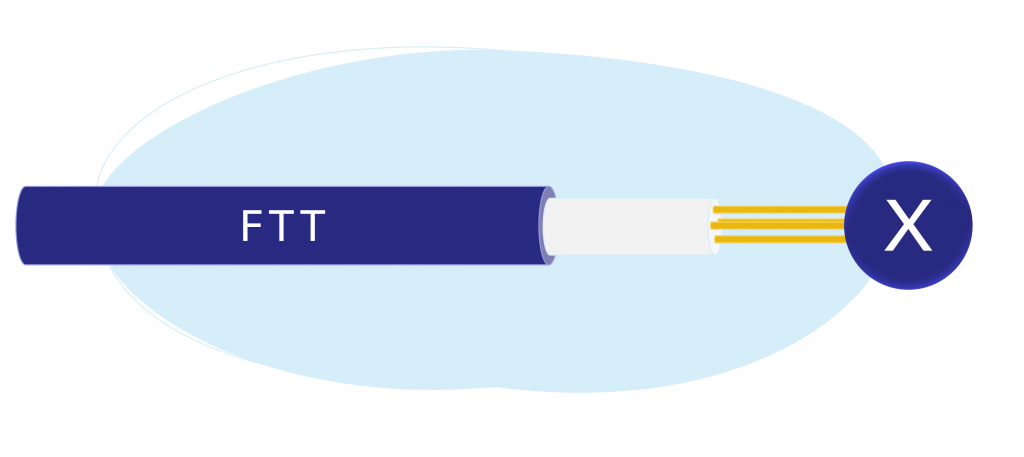
Every network operator who has his own network can choose between several topology options to roll out optical fibre. This choice depends, among other things, on what kind of public he wants to reach (homes or industrial estates), the population density and on whether he wants to roll out a complete or partial optical fibre network.
Read more:
- What is FTTH and FTTx?
- Full optical fibre networks: point-to-point and point-to-multipoint architecture
- Optical fibre roll-out upon request (FTTO) or mass roll-out (FTTH)
- What are partial optical fibre networks?
- Partial optical fibre networks with coax of Wyre (Telenet) and Orange (Voo)
- Partial optical fibre networks with copper of Proximus
What is FTTH and FTTx?
Optical fibre is used for various kinds of connections, see also the page on the possibilities offered by fibre. In Belgium, FTTH roll-out is currently under way. An FTTH network (Fibre To the Home) refers to the optical fibre connection that links the customer to the provider’s telecom network. In case of FTTH this optical fibre enters the home, but there are other FTTx networks, such as:
- FTTB: Fibre to the Building: the optical fibre enters the building (block of flats) and inside the building another type of (copper) cable is used for the individual connections
- FTTO: Fibre to the Office: optical fibre into the office, typically for business purposes
- FTTC: Fibre to the Cabinet: optical fibre up to the street cabinet, after which the homes are connected to that street cabinet by means of another type of (copper) cable.
- FTTA: Fibre to the Antenna: optical fibre to the antenna, after which a wireless signal is sent.
FTTH and FTTO are therefore full optical fibre networks (optical fibre up to the end-customer’s network termination point) and FTTC and FTTA are partial optical fibre networks.
Full optical fibre networks: point-to-point and point-to-multipoint architecture
If the operator wants to roll out a full optical fibre network he has a choice between 2 main categories of network topology: point-to-point or point-to-multipoint.
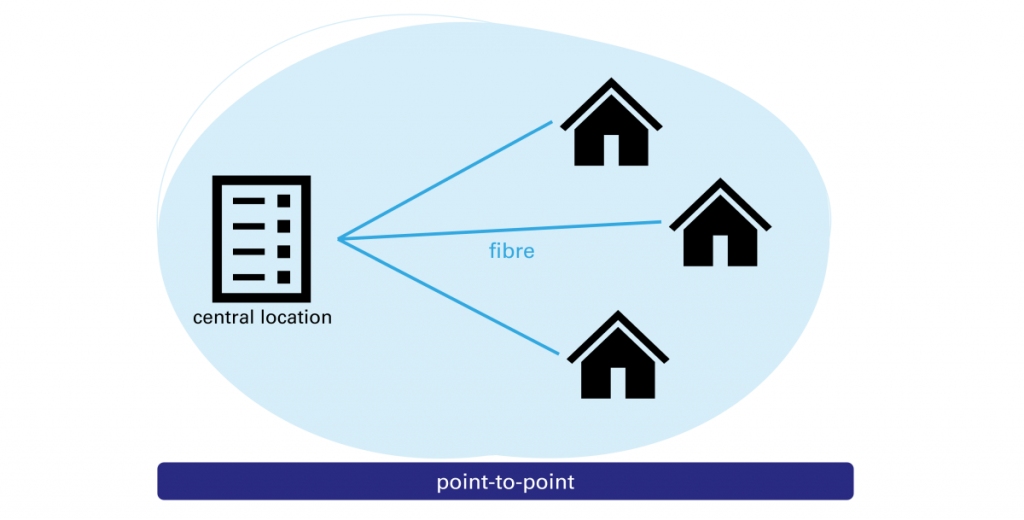
In case of a point-to-point optical fibre network each end-user has his own optical fibre connection to a central location or Point of Presence (PoP). The end-user does not share this individual optical fibre connection with others and can therefore use its full capacity.
This type of network offers the following advantages:
- A capacity the end-user does not have to share with other users. This results in a higher capacity for the user, which can be perfectly symmetrical (identical upload and download speeds).
- More flexible for future technologies still to be developed (more future-proof)
- It is easier for the optical fibre to be “unbundled”: this means that another operator can also use it, simply by disconnecting this optical fibre and by connecting it to his own network. This way more competition is possible (see also the page on active or passive access).
- Easier error detection
- More possibilities regarding quality of service (or “QoS”)
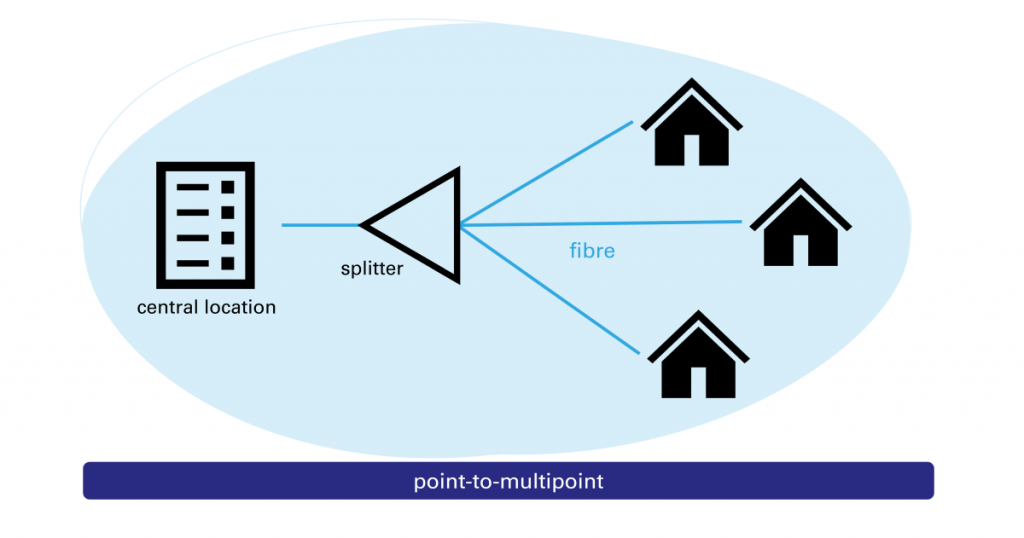
In case of a point-to-multipoint optical fibre network (or a PON network) one or more splitter(s) is/are situated between the central location and the end-users. Those splitters copy the input signal to several output lines, and therefore distribute the signal of an optical fibre among several optical fibres. Therefore, contrary to a point-to-point network, several end-users are connected to a single optical line card in the distribution point, thus sharing the capacity of the optical fibre connection.
Benefits:
- Less optical fibres needed
- Lower roll-out costs for the optical fibre operator
- Easier to roll out on building façades (in cities for example)
Optical fibre roll-out upon request (FTTO) or mass roll-out (FTTH)
The network operator can make a distinction in his optical fibre infrastructure depending on the type of customers he wants to connect.
As such companies in industrial estates are typically connected to a direct point-to-point optical fibre network, consequently called “Fibre to the Office” or an FTTO optical fibre network. This optical fibre connection is only installed at the customer’s express request, making it more expensive than an FTTH connection. Thanks to the point-to-point connection these companies can benefit from the optical fibre’s full capacity.
Homes (but sometimes also companies) are connected differently, i.e. by means of a “Fibre to the Home” or FTTH optical fibre network. This FTTH network can have either a point-to-point or a point-to-multipoint network topology. When rolling out an FTTH network a network operator will choose at which locations he rolls out this optical fibre network. Next he will work out a roll-out plan per district in consultation with the competent authorities.
After having obtained all approvals the network operator will proactively start to install the optical fibre connection in the various streets, either underground or on the façades of homes. The last part, the individual connection of the end-user to this fibre network, usually takes place at the request of the end-customer. A network operator can ask a fee for this.
What are partial optical fibre networks?
A partial optical fibre network consists of a fibre optic cable between a central location and a local collection point. Starting from that local point a non-optical fibre connection then links the end-users. For fixed connections this non-optical fibre connection is either a copper pair or a coaxial cable.
Partial optical fibre networks with coax of Wyre (Telenet) and Orange (Voo)
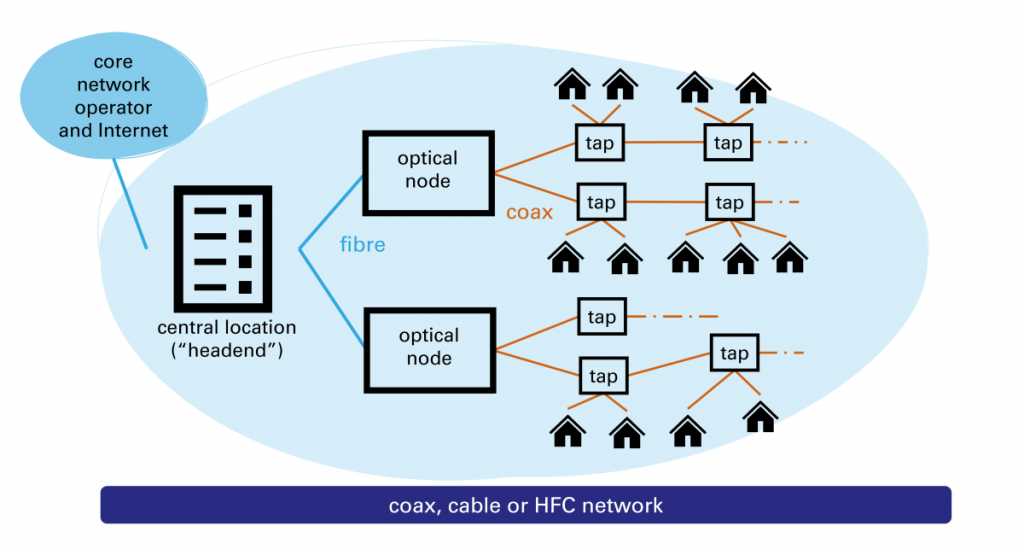
The coaxial or cable network (or HFC network: Hybrid Fibre Coax) of Wyre (Telenet) and Orange (Voo) is the cable television network that has been adapted to enable bidirectional Internet traffic. In these networks too, there is an optical fibre connection between the central point and the local collection point (the optical node). This collection point is the starting point of the coaxial network to the end-users.
The coaxial network consists of subsequent taps (small branches) to which separate groups of customers are connected: this means that the coaxial access network is shared with neighbours, which may impact the quality of the Internet connection.
Contrary to the copper network the maximum speed does not depend on the distance to the distribution point. Just like optical fibre the coaxial network offers high speeds, going up to 1 Gbps nowadays. Although an optical fibre network is a more recent technology (with the possibilities described on the "Possibilities" page), the coax technology also continues to evolve and a cable network currently still meets most broadband needs.
Partial optical fibre networks with copper of Proximus
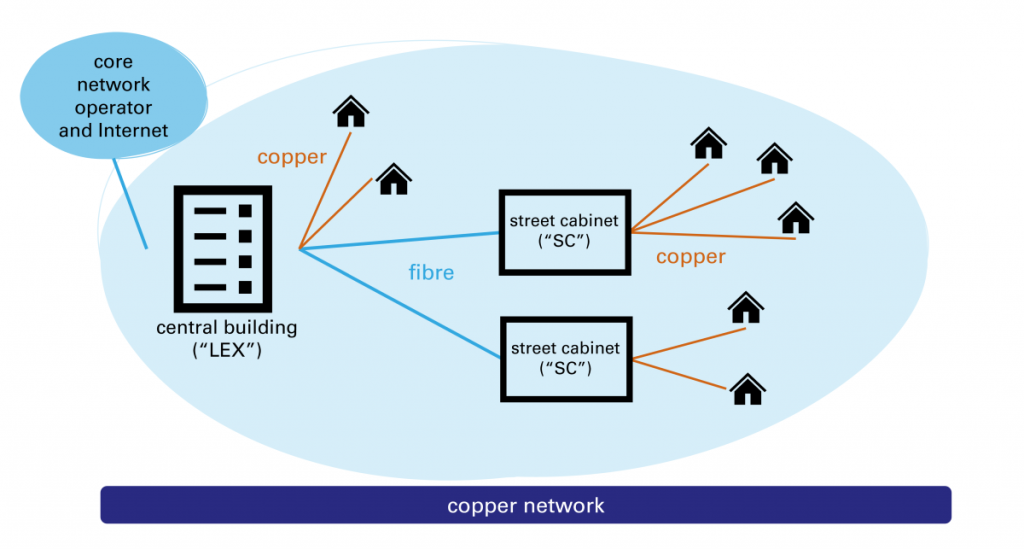
In Belgium Proximus operates the only partial fibre-copper network. A fibre optic cable leaves the central building of Proximus (the LEX or the former telephone exchange) and links it with the local cable distributors in street cabinets (SCs). From those street cabinets an individual copper pair goes to each end-user, which is not shared with other customers.
The fibre-copper network is an evolution from the old copper network, meant for telephony, where the connection starting from the LEX was still entirely copper. By partially replacing this connection with fibre, the total length of the copper cable diminishes, thus making higher speeds possible. On this fibre-copper network Proximus offers a VDSL2 service with download speeds up to 100 Mbps. The maximum speeds that can be reached depend on the distance between the house and the nearest distribution point (usually the street cabinet).
By upgrading this network, even higher speeds up to a few hundreds of Mbps can be made possible, even though those will only be reached at locations close to the street cabinet. The advantage of optical fibre is that much higher speeds are possible at far longer distances from the distribution point. Therefore, in the areas where Proximus has rolled out fibre, it will in time put an end to the services over the copper network.